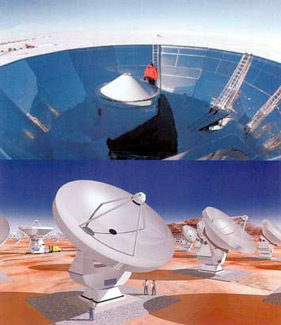| 2005 |

|
YEAR BOOK |
National University of Ireland, Maynooth
|
Studying the origins of structure in the Universe
|

Submillimetre astronomy is often carried out from space, far above the absorbing effects of the atmosphere. However, if a dry site can be found, accesibility and the shorter timescales involved often make ground-based observing a more attractive option for novel measurements and instruments. QUaD and ALMA are two of the exciting new ground-based submillimetre telescopes with which members of the Physics Department of NUI Maynooth are heavily involved.
QUaD is one of the new generation of submillimetre telescopes designed to search for the extremely faint polarisation properties of the Cosmic Microwave Background, the relic radiation left over from the Big Bang. A measurement of this polarisation will allow cosmologists to distinguish between competing models of the early Universe. QUaD was deployed to the South Pole, an excellent site for submillimetre observations, in the 2004/ 2005 summer season. It began observing in March 2005 once the sun had set (the polar winter). This year promises to be a very interesting one for Microwave Background astronomy.
The Atacama Large Millimeter Array (ALMA) is a global collaboration between Europe, America and Japan to build a synthesis radio telescope that will operate at millimetre and submillimetre wavelengths. The main science goal is to better understand the origins of galaxies and stars. ALMA will study the epoch of first galaxy formation, the evolution of galaxies and the dust-obscured star-forming galaxies that optical telescopes cannot see. It will be able to study phases of star formation hidden away in dusty molecular clouds. ALMA is expected to have a major impact on virtually all areas of astronomy.
|
|
For further information contact: [email protected] or see http://physicsresearch.may.ie/submil.shtml